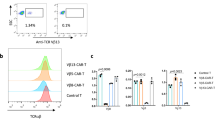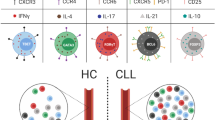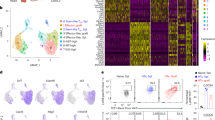Abstract
Mature T-cell lymphomas (MTCLs) have an extremely poor prognosis and are much less frequent than immature T-cell leukemias. This suggests that malignant outgrowth of mature T lymphocytes is well controlled. Indeed, in a previous study we found that mature T cells are resistant to transformation with known T-cell oncogenes. Here, however, we observed that T-cell receptor (TCR) mono-/oligoclonal mature T cells from TCR transgenic (tg) mice (OT-I, P14) expressing the oncogenes NPM/ALK or ΔTrkA readily developed MTCLs in T-cell-deficient recipients. Analysis of cell surface markers largely ruled out that TCR tg lymphomas were derived from T-cell precursors. Furthermore, cotransplanted non-modified TCR polyclonal T cells suppressed malignant outgrowth of oncogene expressing TCR tg T lymphocytes. A dominant role of an anti-leukemic immune response or Tregs in the control of MTCLs seems unlikely as naïve T cells derived from oncogene expressing stem cells, which should be tolerant to leukemic antigens, as well as purified CD4 and CD8 were resistant to transformation. However, our results are in line with a model in which homeostatic mechanisms that stabilize the diversity of the normal T-cell repertoire, for example, clonal competition, also control the outgrowth of potentially malignant T-cell clones. This study introduces a new innate mechanism of lymphoma control.
This is a preview of subscription content, access via your institution
Access options
Subscribe to this journal
Receive 12 print issues and online access
$259.00 per year
only $21.58 per issue
Buy this article
- Purchase on Springer Link
- Instant access to full article PDF
Prices may be subject to local taxes which are calculated during checkout





Similar content being viewed by others
References
Dunleavy K, Piekarz RL, Zain J, Janik JE, Wilson WH, O’Connor OA et al. New strategies in peripheral T-cell lymphoma: understanding tumor biology and developing novel therapies. Clin Cancer Res 2010; 16: 5608–5617.
Min B, Paul WE . Endogenous proliferation: burst-like CD4 T cell proliferation in lymphopenic settings. Semin Immunol 2005; 17: 201–207.
Kirberg J, Berns A, von Boehmer H . Peripheral T cell survival requires continual ligation of the T cell receptor to major histocompatibility complex-encoded molecules. J Exp Med 1997; 186: 1269–1275.
Nesic D, Vukmanovic S . MHC class I is required for peripheral accumulation of CD8+ thymic emigrants. J Immunol 1998; 160: 3705–3712.
Surh CD, Sprent J . Regulation of mature T cell homeostasis. Semin Immunol 2005; 17: 183–191.
Troy AE, Shen H . Cutting edge: homeostatic proliferation of peripheral T lymphocytes is regulated by clonal competition. J Immunol 2003; 170: 672–676.
Newrzela S, Cornils K, Li Z, Baum C, Brugman MH, Hartmann M et al. Resistance of mature T cells to oncogene transformation. Blood 2008; 112: 2278–2286.
Meyer J, Rhein M, Schiedlmeier B, Kustikova O, Rudolph C, Kamino K et al. Remarkable leukemogenic potency and quality of a constitutively active neurotrophin receptor, deltaTrkA. Leukemia 2007; 21: 2171–2180.
Morris SW, Kirstein MN, Valentine MB, Dittmer KG, Shapiro DN, Saltman DL et al. Fusion of a kinase gene, ALK, to a nucleolar protein gene, NPM, in non-Hodgkin's lymphoma. Science 1994; 263: 1281–1284.
Hogquist KA, Jameson SC, Heath WR, Howard JL, Bevan MJ, Carbone FR . T cell receptor antagonist peptides induce positive selection. Cell 1994; 76: 17–27.
Pircher H, Burki K, Lang R, Hengartner H, Zinkernagel RM . Tolerance induction in double specific T-cell receptor transgenic mice varies with antigen. Nature 1989; 342: 559–561.
Chiarle R, Gong JZ, Guasparri I, Pesci A, Cai J, Liu J et al. NPM-ALK transgenic mice spontaneously develop T-cell lymphomas and plasma cell tumors. Blood 2003; 101: 1919–1927.
Kuefer MU, Look AT, Pulford K, Behm FG, Pattengale PK, Mason DY et al. Retrovirus-mediated gene transfer of NPM-ALK causes lymphoid malignancy in mice. Blood 1997; 90: 2901–2910.
de Leval L, Rickman DS, Thielen C, Reynies A, Huang YL, Delsol G et al. The gene expression profile of nodal peripheral T-cell lymphoma demonstrates a molecular link between angioimmunoblastic T-cell lymphoma (AITL) and follicular helper T (TFH) cells. Blood 2007; 109: 4952–4963.
Larson RC, Osada H, Larson TA, Lavenir I, Rabbitts TH . The oncogenic LIM protein Rbtn2 causes thymic developmental aberrations that precede malignancy in transgenic mice. Oncogene 1995; 11: 853–862.
Cattoglio C, Maruggi G, Bartholomae C, Malani N, Pellin D, Cocchiarella F et al. High-definition mapping of retroviral integration sites defines the fate of allogeneic T cells after donor lymphocyte infusion. PLoS One 2010; 5: e15688.
Hematti P, Hong BK, Ferguson C, Adler R, Hanawa H, Sellers S et al. Distinct genomic integration of MLV and SIV vectors in primate hematopoietic stem and progenitor cells. PLoS Biol 2004; 2: e423.
Akagi K, Suzuki T, Stephens RM, Jenkins NA, Copeland NG . RTCGD: retroviral tagged cancer gene database. Nucleic Acids Res 2004; 32 (Database issue): D523–D527.
Suzuki T, Shen H, Akagi K, Morse HC, Malley JD, Naiman DQ et al. New genes involved in cancer identified by retroviral tagging. Nat Genet 2002; 32: 166–174.
Hacein-Bey-Abina S, von Kalle C, Schmidt M, Le Deist F, Wulffraat N, McIntyre E et al. A serious adverse event after successful gene therapy for X-linked severe combined immunodeficiency. N Engl J Med 2003; 348: 255–256.
Hacein-Bey-Abina S, Von Kalle C, Schmidt M, McCormack MP, Wulffraat N, Leboulch P et al. LMO2-associated clonal T cell proliferation in two patients after gene therapy for SCID-X1. Science 2003; 302: 415–419.
Pechloff K, Holch J, Ferch U, Schweneker M, Brunner K, Kremer M et al. The fusion kinase ITK-SYK mimics a T cell receptor signal and drives oncogenesis in conditional mouse models of peripheral T cell lymphoma. J Exp Med 2010; 207: 1031–1044.
Wang X, Werneck MB, Wilson BG, Kim HJ, Kluk MJ, Thom CS et al. TCR-dependent transformation of mature memory phenotype T cells in mice. J Clin Invest 2011; 121: 3834–3845.
Miething C, Grundler R, Fend F, Hoepfl J, Mugler C, von Schilling C et al. The oncogenic fusion protein nucleophosmin-anaplastic lymphoma kinase (NPM-ALK) induces two distinct malignant phenotypes in a murine retroviral transplantation model. Oncogene 2003; 22: 4642–4647.
Bonzheim I, Geissinger E, Roth S, Zettl A, Marx A, Rosenwald A et al. Anaplastic large cell lymphomas lack the expression of T-cell receptor molecules or molecules of proximal T-cell receptor signaling. Blood 2004; 104: 3358–3360.
Geissinger E, Sadler P, Roth S, Grieb T, Puppe B, Muller N et al. Disturbed expression of the T-cell receptor/CD3 complex and associated signaling molecules in CD30+ T-cell lymphoproliferations. Haematologica 2010; 95: 1697–1704.
Newrzela S, Cornils K, Heinrich T, Schlager J, Yi JH, Lysenko O et al. Retroviral insertional mutagenesis can contribute to immortalization of mature T lymphocytes. Mol Med 2011; 17: 1223–1232.
Johnson LA, Morgan RA, Dudley ME, Cassard L, Yang JC, Hughes MS et al. Gene therapy with human and mouse T-cell receptors mediates cancer regression and targets normal tissues expressing cognate antigen. Blood 2009; 114: 535–546.
Morgan RA, Dudley ME, Wunderlich JR, Hughes MS, Yang JC, Sherry RM et al. Cancer regression in patients after transfer of genetically engineered lymphocytes. Science 2006; 314: 126–129.
Kelly JA, Spolski R, Kovanen PE, Suzuki T, Bollenbacher J, Pise-Masison CA et al. Stat5 synergizes with T cell receptor/antigen stimulation in the development of lymphoblastic lymphoma. J Exp Med 2003; 198: 79–89.
Tsatsanis C, Vaporidi K, Zacharioudaki V, Androulidaki A, Sykulev Y, Margioris AN et al. Tpl2 and ERK transduce antiproliferative T cell receptor signals and inhibit transformation of chronically stimulated T cells. Proc Natl Acad Sci USA 2008; 105: 2987–2992.
Schwab R, Szabo P, Manavalan JS, Weksler ME, Posnett DN, Pannetier C et al. Expanded CD4+ and CD8+ T cell clones in elderly humans. J Immunol 1997; 158: 4493–4499.
Tokudome S, Tokunaga O, Shimamoto Y, Miyamoto Y, Sumida I, Kikuchi M et al. Incidence of adult T-cell leukemia/lymphoma among human T-lymphotropic virus type I carriers in Saga, Japan. Cancer Res 1989; 49: 226–228.
Humme D, Lukowsky A, Steinhoff M, Beyer M, Walden P, Sterry W et al. Dominance of nonmalignant T-cell clones and distortion of the TCR repertoire in the peripheral blood of patients with cutaneous CD30+ lymphoproliferative disorders. J Invest Dermatol 2009; 129: 89–98.
Knol AC, Guilloux Y, Quereux G, Marques-Briand S, Pandolfino MC, Khammari A et al. CD8(+) T lymphocytes reactive against Epstein-Barr virus antigens in skin lesions of a patient with Sezary syndrome. J Am Acad Dermatol 2005; 53: 897–900.
Smedby KE, Baecklund E, Askling J . Malignant lymphomas in autoimmunity and inflammation: a review of risks, risk factors, and lymphoma characteristics. Cancer Epidemiol Biomarkers Prev 2006; 15: 2069–2077.
Carbonnel F, Grollet-Bioul L, Brouet JC, Teilhac MF, Cosnes J, Angonin R et al. Are complicated forms of celiac disease cryptic T-cell lymphomas? Blood 1998; 92: 3879–3886.
Acknowledgements
NG was supported by a scholarship of Merck Serono within the Graduiertenkolleg GRK1172 of the Deutsche Forschungs-gemeinschaft. Furthermore, the study was funded by the Deutsche Forschungs-gemeinschaft (LA1135/9-1) within the SPP1230. We thank Ekaterini Hadzoglou and Robin Wistinghausen for their excellent technical assistance. We also thank Felix Hermann, Jörg Kirberg and Ralf Küppers for the highly valuable discussions of the presented data.
AUTHOR CONTRIBUTIONS
SN designed experiments, performed research, analyzed data and wrote the paper. TH performed research, analyzed data and edited the paper. NAG, MP, BR and AK performed research. HMJ performed Ig-rearrangement analysis, SH and MLH performed histological analyses, SG and IR performed the statistical analyses. DVL designed experiments, analyzed data and wrote the paper.
Author information
Authors and Affiliations
Corresponding author
Ethics declarations
Competing interests
The authors declare no conflict of interest.
Additional information
Supplementary Information accompanies the paper on the Leukemia website
Supplementary information
Rights and permissions
About this article
Cite this article
Newrzela, S., Al-Ghaili, N., Heinrich, T. et al. T-cell receptor diversity prevents T-cell lymphoma development. Leukemia 26, 2499–2507 (2012). https://doi.org/10.1038/leu.2012.142
Received:
Revised:
Accepted:
Published:
Issue Date:
DOI: https://doi.org/10.1038/leu.2012.142
Keywords
This article is cited by
-
Retroviral gene therapy in Germany with a view on previous experience and future perspectives
Gene Therapy (2021)
-
Genetic engineering of T cells for immunotherapy
Nature Reviews Genetics (2021)
-
Lymphopenia in Cancer Patients and its Effects on Response to Immunotherapy: an opportunity for combination with Cytokines?
Journal for ImmunoTherapy of Cancer (2019)
-
Engineering T Cells to Functionally Cure HIV-1 Infection
Molecular Therapy (2015)
-
Mature T-cell Lymphomagenesis Induced by Retroviral Insertional Activation of Janus Kinase 1
Molecular Therapy (2013)



